The original co-sponsors of legislation in the House of Representatives to require "paper records" on Electronic Voting Machines and many other security measures and improvements to the Help America Vote Act of 2002, have sent a "Dear Colleague" letter to other members citing the landmark report recently released by the non-partisan Government Accountability Office (GAO) on the myriad security problems found after a year-long investigation into those machines.
In a letter from last Wednesday obtained by The BRAD BLOG, Congressmen Rush Holt (D-NJ) and Tom Davis (R-VA) asked colleagues to join them in support of H.R. 550, known as the "The Voter Confidence and Increased Accessibility Act".
In their letter, the congressmen point out several of the key findings in the GAO report leading off with a quote from it that reads ". . . computer programs could access these cast vote files and alter them without the system recording this action in its audit logs.” [emphasis in original]
The legislation, which currently has more than 150 bi-partisan co-sponsors, has been languishing for some time as House Leadership has kept it from coming up for debate on the House floor or committee mark-up. H.R. 550 is currently "pending" in the House Administrative Committee, according to Holt's Communications Director, Patrick G. Eddington, but it has received "no debate, mark-up or hearing" as of yet. He added, "no Committee has specifically addressed H.R. 550."
H.R. 550 was introduced in April of this year. It was a reintroduction of a predecessor bill, H.R. 2239, which was first introduced in 2003, but was similarly never debated or voted on in any House committee.
The House Administrative Committee is chaired by Ohio Republican Bob Ney who held hearings last March on "Ohio Election Irregularities" in which he called only one witness from any "Voting Rights" group. That group, the self-proclaimed "non-partisan" American Center for Voting Rights, had been formed only days before the hearing, and as reporting by BRAD BLOG has revealed, was formed by two high-level Bush/Cheney/RNC operatives. Ney is also reported to be currently under investigation by the DoJ for his involvement in the ongoing Jack Abramoff lobbying scandal.
Amongst several other points cited in the letter from the GAO reports's findings: Ballot definitions on Electronic Voting Machines may be altered so that "the votes shown on the touch screen for one candidate would actually be recorded and counted for a different candidate."; Programming errror in a Pennsylvania county resulted in an undervote percentage of 80% in some precincts; An "unknown number of disenfranchised voters" as documented by California voting officials; Election monitors in a Florida county discovering a "flaw" in an Electronic Voting Machine ballot that allowed "ballots to be added to the canvas totals multiple times without being detected."; An Electronic Voting system in Ohio added nearly 4,000 votes for Bush in just one precinct during the '04 Presidential Election.
Though the GAO report was non-partisan, requested by the Chairmen and ranking members of three different U.S. House Committees, and was released last month after a year-long investigation along with a rare bi-partisan joint press release which lauded it, not a single wire service or mainstream American newspaper to date, that we know of, has devoted a single paragraph reporting on its release or the information contained within.
The complete text of Holt and Davis' letter to colleagues follows [emphasis in original] ...
". . . computer programs could access these cast vote files
and alter them
without the system recording this action in its audit logs."
GAO Report: ELECTIONS: Federal Efforts to Improve Security and Reliability of Electronic Voting Systems are Under Way, but Key Activities Need to be Completed – September 2005
Dear Colleague:
In May of 2004, the Chairmen and Ranking Members of the Government Reform Committee, the Committee on the Judiciary, and the Committee on Science asked the Government Accountability Office (GAO) to study the security of electronic voting systems because “[e]xperts have indicated that [the software used in electronic voting machines] has security gaps that could potentially allow unscrupulous individuals to alter the vote count, unlawfully impacting election results while leaving no paper trail or other auditable evidence”. The GAO issued its report in response to that request in September 2005. Its findings included the following:
With respect to system failures noted during elections, the GAO concluded that “[w]hile each of these problems was noted in an operational environment, the root cause was not known in all cases.” In addition, it stated that “ . . . election officials in one state noted that when voting machines malfunctioned and started generating error messages during an election, state technicians were unable to diagnose and resolve the problems because the vendor's documentation provided no information about what the error messages meant, or how to fix the problems.” One independent testing authority (ITA) official stated that its “testing does not guarantee that voting systems are secure and reliable.”
The Voter Confidence and Increased Accessibility Act (H.R. 550) would amend the Help America Vote Act to protect the electoral system from those risks, in time for the general election in 2006. In addition, it would create a uniform national standard for independent auditability of election results, by mandating that the voter-verified paper record – the only record verified by the voters rather than by the machines --- be treated as the vote of record. That way, voters in every state will be confident that the results reported in every other state will be of equal verifiability and integrity.
The Voter Confidence and Increased Accessibility Act had 50 original bipartisan cosponsors when it was introduced in February, and now it has almost 160. It has been endorsed by VerifiedVoting.org as the “gold standard” of verifiability legislation. If we do not pass this legislation, we may as well outlaw recounts in federal elections. For more information or to become a cosponsor, please contact Michelle Mulder of Representative Holt's staff at (###) ###-#### or [removed]@mail.house.gov.
Sincerely,
RUSH HOLT
Member of Congress
TOM DAVIS
Member of Congress


 Trump Blinks, Chaos Reigns, Markets Spike as Many Tariffs Remain Despite 90-Day 'Pause': 'BradCast' 4/9/25
Trump Blinks, Chaos Reigns, Markets Spike as Many Tariffs Remain Despite 90-Day 'Pause': 'BradCast' 4/9/25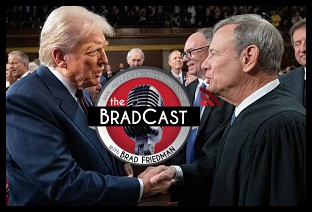 SCOTUS Ruling on Deportations Even Grimmer Than First Appears: 'BradCast' 4/8/25
SCOTUS Ruling on Deportations Even Grimmer Than First Appears: 'BradCast' 4/8/25 'Green News Report' 4/8/25
'Green News Report' 4/8/25
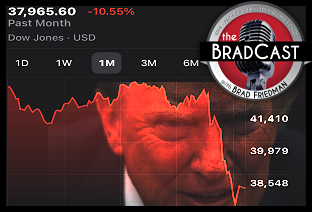 Cliff Diving with Donald: 'BradCast' 4/7/25
Cliff Diving with Donald: 'BradCast' 4/7/25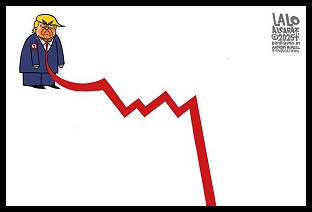 Sunday 'Don't Look Down' Toons
Sunday 'Don't Look Down' Toons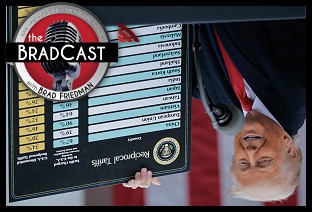 'Mob Boss' Trump's Global Trade Sanctions Tank U.S., World Markets: 'BradCast' 4/3/25
'Mob Boss' Trump's Global Trade Sanctions Tank U.S., World Markets: 'BradCast' 4/3/25 'Green News Report' 4/3/25
'Green News Report' 4/3/25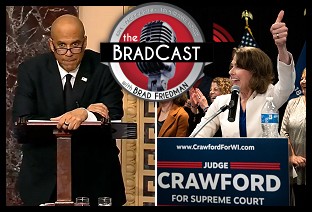 Dems Step Up: Crawford Landslide in WI; Booker Makes History in U.S. Senate: 'BradCast' 4/2/25
Dems Step Up: Crawford Landslide in WI; Booker Makes History in U.S. Senate: 'BradCast' 4/2/25 Judge Dismisses Long-Running Challenge to GA's Unverifiable, Insecure E-Vote System: 'BradCast' 4/1/25
Judge Dismisses Long-Running Challenge to GA's Unverifiable, Insecure E-Vote System: 'BradCast' 4/1/25 'Green News Report' 4/1/25
'Green News Report' 4/1/25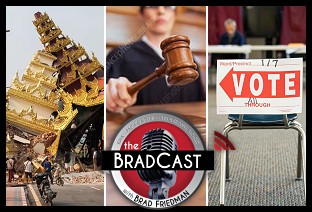 Bad Court and Election News for Trump is Good News for America: 'BradCast' 3/31
Bad Court and Election News for Trump is Good News for America: 'BradCast' 3/31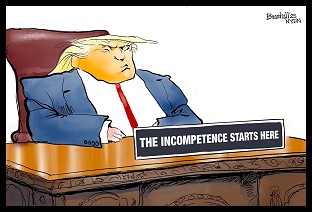 Sunday 'Great Start!' Toons
Sunday 'Great Start!' Toons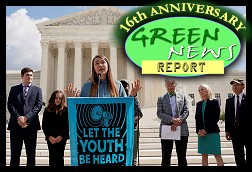 'Green News Report' 3/27/25
'Green News Report' 3/27/25 Vets Push Back at Plan to Slash Health Care, 80K V.A. Jobs: 'BradCast' 3/27/25
Vets Push Back at Plan to Slash Health Care, 80K V.A. Jobs: 'BradCast' 3/27/25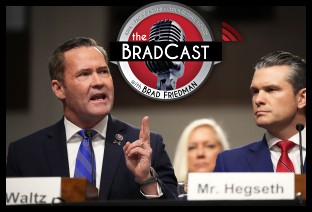 Signal Scandal Worsens for Trump, GOP; Big Dem Election Wins in PA: 'BradCast' 3/26
Signal Scandal Worsens for Trump, GOP; Big Dem Election Wins in PA: 'BradCast' 3/26 'Emptywheel': Trump NatSec Team Should 'Resign in Disgrace': 'BradCast' 3/25/25
'Emptywheel': Trump NatSec Team Should 'Resign in Disgrace': 'BradCast' 3/25/25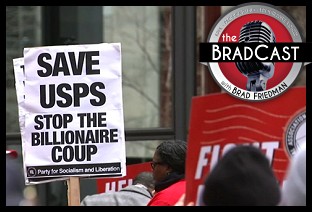 USPS 'Belongs to the People, Not the Billionaires': 'BradCast' 3/24/25
USPS 'Belongs to the People, Not the Billionaires': 'BradCast' 3/24/25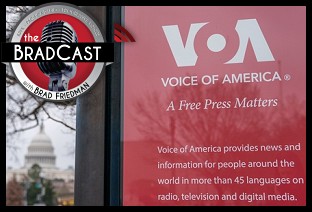 We're ALL Voice of America Now: 'BradCast' 3/20/25
We're ALL Voice of America Now: 'BradCast' 3/20/25 What Trump's 'Timber Production Expansion' Means (and Costs): 'BradCast' 3/19/25
What Trump's 'Timber Production Expansion' Means (and Costs): 'BradCast' 3/19/25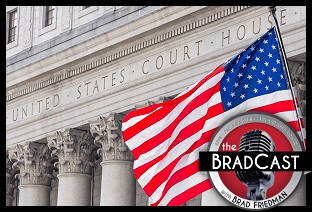 Courts Largely Holding Against Trump, Musk Lawlessness: 'BradCast' 3/18/25
Courts Largely Holding Against Trump, Musk Lawlessness: 'BradCast' 3/18/25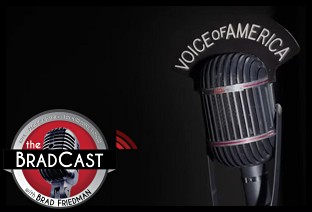 Chief VOA Reporter on Outlet Falling Silent First Time Since 1942: 'BradCast' 3/17/25
Chief VOA Reporter on Outlet Falling Silent First Time Since 1942: 'BradCast' 3/17/25
 VA GOP VOTER REG FRAUDSTER OFF HOOK
VA GOP VOTER REG FRAUDSTER OFF HOOK Criminal GOP Voter Registration Fraud Probe Expanding in VA
Criminal GOP Voter Registration Fraud Probe Expanding in VA DOJ PROBE SOUGHT AFTER VA ARREST
DOJ PROBE SOUGHT AFTER VA ARREST Arrest in VA: GOP Voter Reg Scandal Widens
Arrest in VA: GOP Voter Reg Scandal Widens ALL TOGETHER: ROVE, SPROUL, KOCHS, RNC
ALL TOGETHER: ROVE, SPROUL, KOCHS, RNC LATimes: RNC's 'Fired' Sproul Working for Repubs in 'as Many as 30 States'
LATimes: RNC's 'Fired' Sproul Working for Repubs in 'as Many as 30 States' 'Fired' Sproul Group 'Cloned', Still Working for Republicans in At Least 10 States
'Fired' Sproul Group 'Cloned', Still Working for Republicans in At Least 10 States FINALLY: FOX ON GOP REG FRAUD SCANDAL
FINALLY: FOX ON GOP REG FRAUD SCANDAL COLORADO FOLLOWS FLORIDA WITH GOP CRIMINAL INVESTIGATION
COLORADO FOLLOWS FLORIDA WITH GOP CRIMINAL INVESTIGATION CRIMINAL PROBE LAUNCHED INTO GOP VOTER REGISTRATION FRAUD SCANDAL IN FL
CRIMINAL PROBE LAUNCHED INTO GOP VOTER REGISTRATION FRAUD SCANDAL IN FL Brad Breaks PA Photo ID & GOP Registration Fraud Scandal News on Hartmann TV
Brad Breaks PA Photo ID & GOP Registration Fraud Scandal News on Hartmann TV  CAUGHT ON TAPE: COORDINATED NATIONWIDE GOP VOTER REG SCAM
CAUGHT ON TAPE: COORDINATED NATIONWIDE GOP VOTER REG SCAM CRIMINAL ELECTION FRAUD COMPLAINT FILED AGAINST GOP 'FRAUD' FIRM
CRIMINAL ELECTION FRAUD COMPLAINT FILED AGAINST GOP 'FRAUD' FIRM RICK SCOTT GETS ROLLED IN GOP REGISTRATION FRAUD SCANDAL
RICK SCOTT GETS ROLLED IN GOP REGISTRATION FRAUD SCANDAL VIDEO: Brad Breaks GOP Reg Fraud Scandal on Hartmann TV
VIDEO: Brad Breaks GOP Reg Fraud Scandal on Hartmann TV RNC FIRES NATIONAL VOTER REGISTRATION FIRM FOR FRAUD
RNC FIRES NATIONAL VOTER REGISTRATION FIRM FOR FRAUD EXCLUSIVE: Intvw w/ FL Official Who First Discovered GOP Reg Fraud
EXCLUSIVE: Intvw w/ FL Official Who First Discovered GOP Reg Fraud GOP REGISTRATION FRAUD FOUND IN FL
GOP REGISTRATION FRAUD FOUND IN FL


































